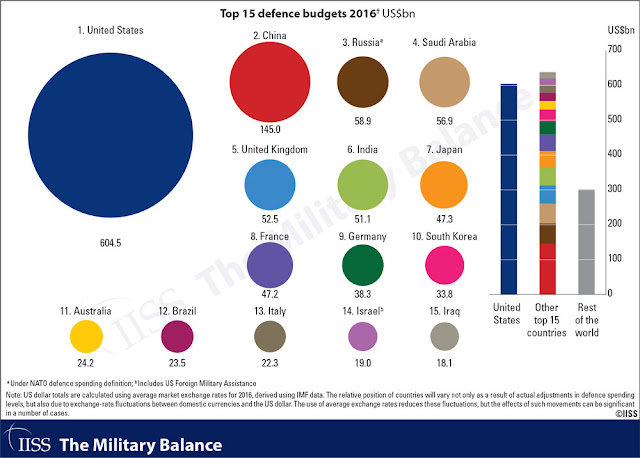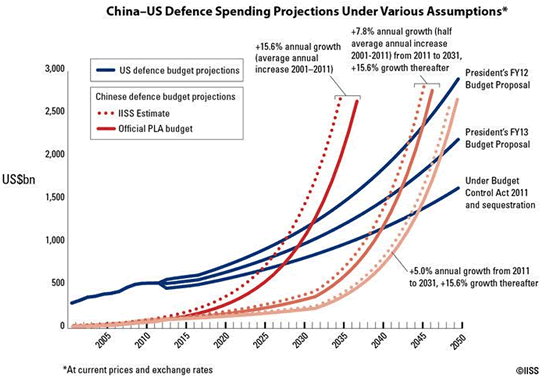US military technology superiority is challenged as reaching near parity in some capability areas
by noreply@blogger.com (brian wang) from NextBigFuture.com on (#2DBK5)
The Military Balance 2017 is the annual assessment of global military capabilities and defence economics from the IISS (International Institute for Strategic Studies, London)
There has been no reduction in the range and number of security challenges demanding the attention of policymakers. Conflict and insecurity continue in Africa, the Middle East and, in the case of Ukraine, in Europe too. North Korea still develops and tests its missile capabilities. More attacks in 2016 highlighted the challenge from transnational terrorists. More states are willing to take military action in pursuit of their national security objectives. Meanwhile, the balance of global military spending continues to shift towards Asia.
From 2012 to 2016, real-terms defence spending across Asia grew by 5-6% each year. However, total global military spending in 2016 fell by 0.4% in real terms when compared to 2015, largely driven by reductions in the Middle East. The fall would have been larger were it not offset by increases in Asia. After overtaking Europe as the second largest defence spending region in 2012, Asia in 2016 spent 1.3 times more than Europe on defense when measured in constant 2010 US$.

It is expected that China's military budget will be about $233 billion in 2020. China's actual military budget is generally considered to be larger than its official budget.
 2013 IISS estimate of future military budgets for China and the USA. Generally not until 2030-2040 will China pass the US in military budgets
2013 IISS estimate of future military budgets for China and the USA. Generally not until 2030-2040 will China pass the US in military budgets
Western military technological superiority, once taken for granted, is increasingly challenged. We now judge that in some capability areas, particularly in the air domain, China appears to be reaching near-parity with the West. Also, Beijing is now beginning to offer for export some of its modern military systems. Across the globe advanced military capabilities are spreading. There is a growing proliferation of lethality, and the increasing sophistication of these systems risks complicating Western states' military options.
The USA still spends the most, and retains the world's most powerful military forces. Nonetheless, Western military systems are increasingly complex and costly, and there are also fewer of them. Taken together with a security environment that is progressively more uncertain, this would indicate that Western states, no matter how large, will in future be able to do less, less effectively, by acting on their own.
China
For years China was engaged primarily in the imitative manufacture of former Soviet-era or Russian systems. This is still the case but now in key areas China is shifting to the domestic research, development and manufacture of military systems, supported by sustained budget increases. Beijing's official budget is 1.8 times higher than those of South Korea and Japan combined and accounted for more than a third of Asia's total spend in 2016.
China's navy has developed and deployed more advanced capabilities. Work has started on building three Type-055 cruisers. At least 13 Type-052D multi-mission destroyers are in service or under construction and a growing number of China's modern surface combatants are being fitted with phased-array radars. Commissioning in 2016 of an additional three large replenishment ships indicates that China's navy is resolutely pursuing its blue water plans - as does China's nascent naval facility in Djibouti. China's Coast Guard is also receiving larger vessels and is now larger than some regional navies by overall fleet size.
In the air domain, China is now seen as the 'pacing threat' for the US. China's progress in research and development, and its improved military capabilities, mean that it is now the single most important driver for US defence developments. This year's Military Balance assesses that China's air force has just introduced into service a highly capable short-range missile in a class only a handful of leading aerospace nations are able to develop. The introduction of this weapon - called the PL-10 - reflects the sustained and continuing investment China is making in air-launched guided weapons. Beijing will almost certainly be able to add increasingly capable airto-air weapons to its inventory in the next few years.
These systems will be close to parity with similar Western weapons, while one of China's air-to-air missiles has no Western equivalent.
China is developing what could be the world's longest range air-to-air missile. Seen on exercise last year and estimated at near six meters in length, this developmental missile likely has the task of engaging large high-value and non-manoeuvring targets. With a lofted trajectory, an engagement range around 300km would appear feasible. When it enters service, this new system will hold at risk.
Not only is China producing more advanced systems. It is also starting to sell these abroad. Last year we noted how Chinese military exports to Africa were moving from the sale of Soviet-era designs to the export of systems designed in China.
This trend continues. China is now, however, also beginning to sell more advanced systems. The PL-10 missile, for instance, is being offered for export and would, if it proliferates, complicate the operations of any Western air force. China is also exporting armed UAVs, and Chinese origin systems have been seen in Nigeria and Saudi Arabia. With China now selling abroad its armed UAVs, it is possible that states unable to procure Western systems may now be able to secure similar capability from non-Western sources.
Read more










There has been no reduction in the range and number of security challenges demanding the attention of policymakers. Conflict and insecurity continue in Africa, the Middle East and, in the case of Ukraine, in Europe too. North Korea still develops and tests its missile capabilities. More attacks in 2016 highlighted the challenge from transnational terrorists. More states are willing to take military action in pursuit of their national security objectives. Meanwhile, the balance of global military spending continues to shift towards Asia.
From 2012 to 2016, real-terms defence spending across Asia grew by 5-6% each year. However, total global military spending in 2016 fell by 0.4% in real terms when compared to 2015, largely driven by reductions in the Middle East. The fall would have been larger were it not offset by increases in Asia. After overtaking Europe as the second largest defence spending region in 2012, Asia in 2016 spent 1.3 times more than Europe on defense when measured in constant 2010 US$.

It is expected that China's military budget will be about $233 billion in 2020. China's actual military budget is generally considered to be larger than its official budget.
 2013 IISS estimate of future military budgets for China and the USA. Generally not until 2030-2040 will China pass the US in military budgets
2013 IISS estimate of future military budgets for China and the USA. Generally not until 2030-2040 will China pass the US in military budgetsWestern military technological superiority, once taken for granted, is increasingly challenged. We now judge that in some capability areas, particularly in the air domain, China appears to be reaching near-parity with the West. Also, Beijing is now beginning to offer for export some of its modern military systems. Across the globe advanced military capabilities are spreading. There is a growing proliferation of lethality, and the increasing sophistication of these systems risks complicating Western states' military options.
The USA still spends the most, and retains the world's most powerful military forces. Nonetheless, Western military systems are increasingly complex and costly, and there are also fewer of them. Taken together with a security environment that is progressively more uncertain, this would indicate that Western states, no matter how large, will in future be able to do less, less effectively, by acting on their own.
China
For years China was engaged primarily in the imitative manufacture of former Soviet-era or Russian systems. This is still the case but now in key areas China is shifting to the domestic research, development and manufacture of military systems, supported by sustained budget increases. Beijing's official budget is 1.8 times higher than those of South Korea and Japan combined and accounted for more than a third of Asia's total spend in 2016.
China's navy has developed and deployed more advanced capabilities. Work has started on building three Type-055 cruisers. At least 13 Type-052D multi-mission destroyers are in service or under construction and a growing number of China's modern surface combatants are being fitted with phased-array radars. Commissioning in 2016 of an additional three large replenishment ships indicates that China's navy is resolutely pursuing its blue water plans - as does China's nascent naval facility in Djibouti. China's Coast Guard is also receiving larger vessels and is now larger than some regional navies by overall fleet size.
In the air domain, China is now seen as the 'pacing threat' for the US. China's progress in research and development, and its improved military capabilities, mean that it is now the single most important driver for US defence developments. This year's Military Balance assesses that China's air force has just introduced into service a highly capable short-range missile in a class only a handful of leading aerospace nations are able to develop. The introduction of this weapon - called the PL-10 - reflects the sustained and continuing investment China is making in air-launched guided weapons. Beijing will almost certainly be able to add increasingly capable airto-air weapons to its inventory in the next few years.
These systems will be close to parity with similar Western weapons, while one of China's air-to-air missiles has no Western equivalent.
China is developing what could be the world's longest range air-to-air missile. Seen on exercise last year and estimated at near six meters in length, this developmental missile likely has the task of engaging large high-value and non-manoeuvring targets. With a lofted trajectory, an engagement range around 300km would appear feasible. When it enters service, this new system will hold at risk.
Not only is China producing more advanced systems. It is also starting to sell these abroad. Last year we noted how Chinese military exports to Africa were moving from the sale of Soviet-era designs to the export of systems designed in China.
This trend continues. China is now, however, also beginning to sell more advanced systems. The PL-10 missile, for instance, is being offered for export and would, if it proliferates, complicate the operations of any Western air force. China is also exporting armed UAVs, and Chinese origin systems have been seen in Nigeria and Saudi Arabia. With China now selling abroad its armed UAVs, it is possible that states unable to procure Western systems may now be able to secure similar capability from non-Western sources.
Read more